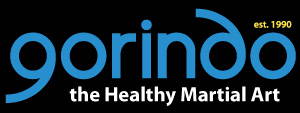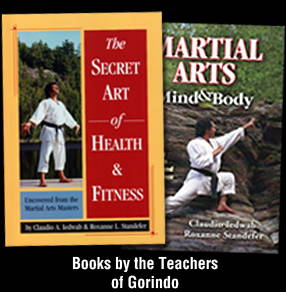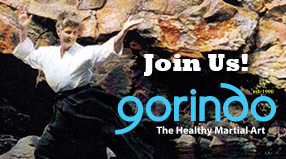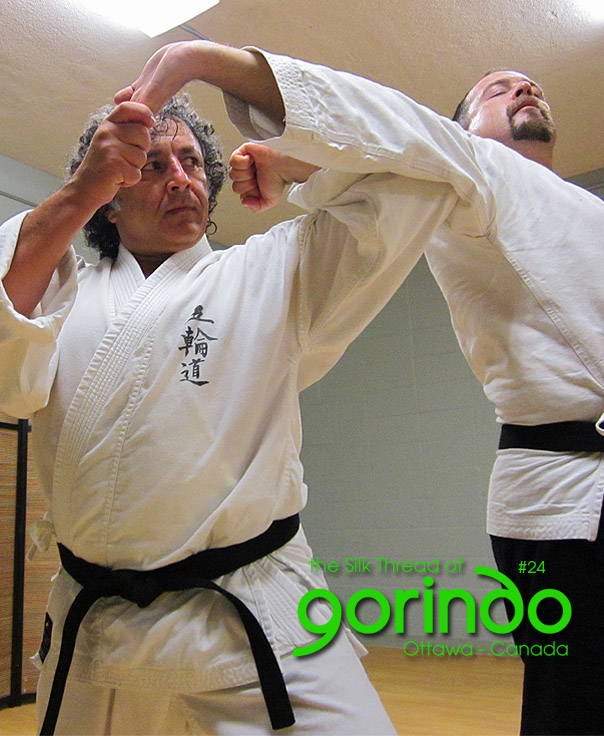
The Silk Thread of Gorindo - Ottawa - Canada
Issue 24
- Keeping in Line with Your Spine (Part 2)
- Kihon - Practicing One Step - Intro Level
Cover Claudio Iedwab Sensei & Joe Pach Sempai - Photo by ©2012 Roxanne Standefer
Keeping in Line with Your Spine (Part 2)
< read Part 2 (previous issue)
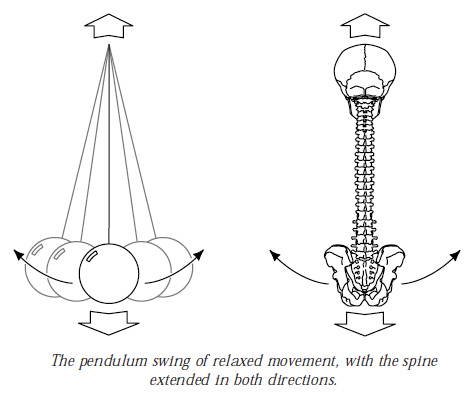
One of the first things taught to a student entering a Japanese dojo is how to bow from this upright standing position. This is performed by bringing feet together and bending forward with spine and head in line dropping to a thirty degree angle (or lower if the respect accorded by the bow requires it) and returning to the natural stance from this bow. This is a lesson in attitude, both the mental (respect, order, calmness) and the physical (as in the position of an aircraft in relation to a certain direction or plane).
Next, the student learns how to sit correctly in seiza for meditation, with head and upper body erect, and contemplating his navel or hara (actually a bit below and to the inside of the belly button) as he breathes from the abdomen.
 Although the seiza position (with head and spine in line) requires some practice and flexibility to achieve, its usefulness in locating the breathing and center of gravity around the hara is important. For the beginner, learning to feel the orientation of the body in space, with the eyes closed, is more easily achieved in the seiza position than standing, where balance can be compromised.
Although the seiza position (with head and spine in line) requires some practice and flexibility to achieve, its usefulness in locating the breathing and center of gravity around the hara is important. For the beginner, learning to feel the orientation of the body in space, with the eyes closed, is more easily achieved in the seiza position than standing, where balance can be compromised.
Breathing to provide maximum metabolic efficiency also demands a posture that will allow diaphragm movement, and controlled contraction and relaxation of the abdominal muscles. It is interesting to note the relationship of breathing to spinal alignment and how many of the martial arts breathing exercises, when properly performed, actually bring the spine into good alignment as the abdomen expands and reduces the compression of the vertebrae.
In basic kihon (fundamental exercise drills), various stances are introduced that move from the natural erect position. Beginning with hands on the hips, the student is able to feel the position of the pelvis and is reminded to keep the weight low for stability. Most martial arts uniforms incorporate a sash, or obi, that is worn low on the hips as a further aid to body memory. The traditional Japanese hakama, a wide-legged pantaloon, is constructed with a stiff card across the lower back, and is tied in an elaborate fashion across the hips and under the hara to provide support for correct posture. As well, the hakama reinforces the triangulated stable base image and forces the wearer to move deliberately with the feet and hips.
With well-constructed stances the martial artist will feel himself riding his lower body with an erect, balanced posture. Keeping the head poised and in line with the upper spine permits smooth movement when walking or shifting from one stance to the other. Enforcing the discipline of correct posture and technique, “building from the ground up,” challenges the patience of the beginning student and teacher alike, but is often what separates the excellent from the merely competent technique as the student progresses. The success of the martial artist in terms of being able to train without injury, and perform increasingly demanding technique, depends on being attentive and dedicated to good form in stances and movement.

The martial artist learns early on that where the head goes, the body will soon follow. The head is a rather heavy ball of brain and bone connected to the body through a narrow channel of muscle, cartilage, and some bony material. If this ball rolls off its pedestal in any direction it tends to pull its base with it. The rest of the spine strains against this unbalancing and creates unnecessary and harmful tension in the body. This can interfere with the technique and impede the body’s attempt to properly apply energy.
Relaxed attentiveness is the key to maintaining alignment and proper posture while moving. Learning to sit or stand correctly is a beginning, but of little value if that knowledge cannot be transferred to the body in motion. Progressively introducing new elements of balance such as turning, twisting, standing on one foot, jumping, and so on, allows the martial artist to incorporate the action into a mental awareness of body position. Learning to sense, control, and naturally coordinate the head, neck, hip, and spine requires good instruction and consistent practice.
Most of us (as we engage in the aforementioned squirming in our chair to sit up straight) think that correct posture requires muscular effort and does not feel relaxed. While this may be true for the couch potatoes among us, the martial artist works hard on the conditioning of the body, not just to be able to perform actively, but also for the reward of relaxing without strain, tension, or weakness. In addition, for both the sedentary and the active, consciously sitting, standing, or moving in line will energize the body, awaken the mind, and allow for more focus and endurance when performing tasks. This is of value for those who spend long hours working at a computer, driving, walking a beat, or any routine activity that leads easily to fatigue.
Learning how to strengthen the muscles of the back, abdomen, hips and shoulders to allow for strong movement and correct alignment is a training goal of martial arts. Finding the right balance of relaxation and tension, moving quickly between the two, and localizing those muscles that need to be contracted while others are relaxed, is all part of the repetitive training found in kihon practice.
Excerpt from “The Secret Art of Health & Fitness – Uncovered from the Martial Arts Masters” by Claudio Iedwab & Roxanne Standefer
© 2012 Illustrations by Claudio Iedwab
- Keeping in Line with Your Spine (Part 2)
- Kihon - Practicing One Step - Intro Level
« Click the Subscribe link on the left
